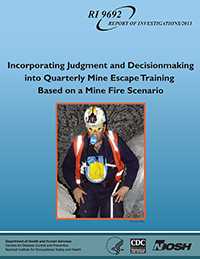Mining Publication: Incorporating Judgment and Decisionmaking into Quarterly Mine Escape Training Based on a Mine Fire Scenario
Original creation date: November 2013
The major coal mine disasters of 2006 raised a number of issues about mine emergency preparedness and response. These included concerns about miners’ judgment and decisionmaking skills under the stress of a mine escape and miners’ familiarity with escape procedures. In response, researchers from the National Institute for Occupational Safety and Health (NIOSH) sought to learn how mines are incorporating judgment and decisionmaking skills into mine escape training. They took an in-depth look at previous research on judgment and decisionmaking in self-rescue and escape training. They also conducted interviews with safety and training personnel from six underground coal operations to understand how mine operators are conducting mandatory quarterly escape training. This report discusses findings from these interviews, presents an analysis of previous research on judgment and decisionmaking in self-rescue and escape, and offers guidance to trainers on how to build judgment and decisionmaking into quarterly training drills.
Authors: MJ Brnich, EE Hall
Report of Investigations - November 2013
NIOSHTIC2 Number: 20043381
Pittsburgh, PA: U.S. Department of Health and Human Services, Centers for Disease Control and Prevention, National Institute for Occupational Safety and Health, DHHS (NIOSH) Publication No. 2014-101 (RI 9692), 2013 Nov; :1-16.
See Also
- Age Awareness Training for Miners
- Emergency Response Planning for Small Mines: Who Needs It?
- An Examination of Antecedents to Coal Miners' Hearing Protection Behaviors: A Test of the Theory of Planned Behavior
- Mine Emergency Response Command Center Training Using Computer Simulation
- Mine Rescue Training Facility Inventory - Compendium of Ideas to Improve US Coal Mine Rescue Training
- Modernization and Further Development of the NIOSH Mine Emergency Response Training System (MERITS), Phase 1
- Refuge Alternatives in Underground Coal Mines
- Technology News 496 - NIOSH Releases New Computer-Based Training Exercise Called MERITS
- Technology News 513 - Coaching Workshop for On-the-Job Trainers
- When Do You Take Refuge? Decisionmaking During Mine Emergency Escape
- Content source: National Institute for Occupational Safety and Health, Mining Program


 ShareCompartir
ShareCompartir
